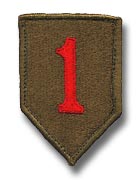| If you do NOT see the Table of Contents frame to the left of this page, then Click here to open 'USArmyGermany' frameset |
|||||||||||||||||||||||||||
1st Infantry Division |
|||||||||||||||||||||||||||
|
|
|||||||||||||||||||||||||||
|
|||||||||||||||||||||||||||
|
|
|||||||||||||||||||||||||||
| Division History | |||||||||||||||||||||||||||
| 1945 - 1955 | |||||||||||||||||||||||||||
|
|||||||||||||||||||||||||||
| Operation GYROSCOPE | |||||||||||||||||||||||||||
| 1955 | |||||||||||||||||||||||||||
| (Source: Email from Bennett Dickson, Army dependent, 1st Infantry Div) | |||||||||||||||||||||||||||
|
|||||||||||||||||||||||||||
I later served a total of 9 1/2 years in Germany in the 3d Armored Division and 8th Infantry Division in Gelnhausen, Hanau, Mainz, and Bad Kreuznach from 1971-75 and 1981-86. We left Germany in 1986 and went to Ft. Riley (where else?) where I commanded the 5th Battalion, 16th Infantry.
On another page, you have the 16th Infantry Regiment in Furth from 1951-55. They were at Ledward Barracks, Schweinfurt in 1954-55. Great web site, glad so see someone doing the labor of love to document all of this, it's almost all gone now. |
|||||||||||||||||||||||||||
| 1st Infantry Division Troops | |||||||||||||||||||||||||||
Headquarters, 1st Infantry Division 63rd Tank Bn 1st Medical Bn . . . . |
|||||||||||||||||||||||||||
| HQ 1st Infantry Division | |||||||||||||||||||||||||||
 Emery Barracks, Würzburg, home of HQ 1st Infantry Division, c. 1953 (Wilmer Braunel) |
|||||||||||||||||||||||||||
Emery Barracks, early 1950s (Anne (Tubinis) Audette) |
|||||||||||||||||||||||||||
| (Source: Email from Anne (Tubinis) Audette, daughter of a former member of the 1st Inf Div, 1951-53) | |||||||||||||||||||||||||||
| Headquarters troops of the 1st Infantry Division were stationed at Emery Barracks in the 1951-53 timeframe. | |||||||||||||||||||||||||||
| 1952 | |||||||||||||||||||||||||||
| 1954 | |||||||||||||||||||||||||||
 Hq building, 1st Infantry Division, Emery Barracks, 1954 (Webmaster's collection) |
|||||||||||||||||||||||||||
| 1955 | |||||||||||||||||||||||||||
| (Source: various STARS & STRIPES issues) | |||||||||||||||||||||||||||
Airfields under 1st Infantry Division control (1955) :
|
|||||||||||||||||||||||||||
| 122nd Transportation Truck Battlion | |||||||||||||||||||||||||||
| 1948 | |||||||||||||||||||||||||||
| (Source: STARS & STRIPES, Dec 18, 1948) | |||||||||||||||||||||||||||
| The 122nd Transportation Battalion with six transportation truck companies is assigned to the 1st Inf Div for logistical support of the division's infantry troops. The battalion headquarters is located at South Kaserne (later known as Merrell Kaserne). Attached units are the 24th, 57th, 58th, 63rd, 544th and 590th Truck Companies. In a combat situation, two truck companies would be attached to each of the three infantry regiments in the 1st Division to transport them. |
|||||||||||||||||||||||||||
| (Source: Email from Everette Coppock) | |||||||||||||||||||||||||||
|
|||||||||||||||||||||||||||
| 1951 | |||||||||||||||||||||||||||
| ORGANIZATION (1951): | |||||||||||||||||||||||||||
|
|||||||||||||||||||||||||||
| 701st Ordnance Maintenance Battalion | |||||||||||||||||||||||||||
 701st Ord Maint Bn DUI (The distinctive unit insignia was originally approved for the 701st Ordnance Battalion on 26 May 1954) 701st Ord Maint Bn DUI (The distinctive unit insignia was originally approved for the 701st Ordnance Battalion on 26 May 1954) |
|||||||||||||||||||||||||||
| 1952 | |||||||||||||||||||||||||||
| (Source: STARS & STRIPES, Nov 9, 1952) | |||||||||||||||||||||||||||
| The 701st Ordnance Maintenance Company is located at Würzburg and commanded by Maj Homer D. Smith, Jr. The company's mission is to issue and maintain all types of ordnance equipment, including vehicles, tanks, artillery, small arms and fire control instruments. Supplying the division's needs for spare parts is the responsibility of the Supply Platoon. In order to carry out its supply function in the field, the platoon takes with it 20 trucks and trailers that it uses as mobile warehouses. Each truck houses certain spare parts so when a requisition is made to the platoon, it can find the part quickly. The company's two maintenance platoons only handle third echelon maintenance. For a 1st Inf Div unit to have a vehicle repaired, it must send the damaged vehicle to the 701st and submit a job order to the 701st shop office. The requisition form must state as nearly as possible the amount of work involved to repair the vehicle. The next step is a complete technical inspection on the vehicle to determine if the 701st has the parts and facilities available for the repairs. If the 701st does not have the parts, the vehicle will be held by the company while the supply platoon requisiitons the parts. If the parts are available or once the requisitioned parts are received, the vehicle is moved into the automotive shop where technical workers take over. After the repair work is completed, the vehicle is sent to the Service and Recovery section, if necessary. This is were carpenters, painters, and battery repairmen do their job. After the vehicle is back in serviceable condition, it is picked up by the user unit. |
|||||||||||||||||||||||||||
| 1953 | |||||||||||||||||||||||||||
| (Source: 701st Maintenance Battalion AHR FY 1982) | |||||||||||||||||||||||||||
| The 701st Ordnance Maintenance Company was reorganized and redesignated on 1 April 1953 as Headquarters and Headquarters Company, 701st Ordnance Maintenance Battalion. The distinctive unit insignia for the battalion was originally approved on 26 May 1954. |
|||||||||||||||||||||||||||
| 1954 | |||||||||||||||||||||||||||
| (Source: 36th Anniversary Issue of the AMERICAN TRAVELER, August 1953) | |||||||||||||||||||||||||||
|
Related Links: |
|||||||||||||||||||||||||||

















